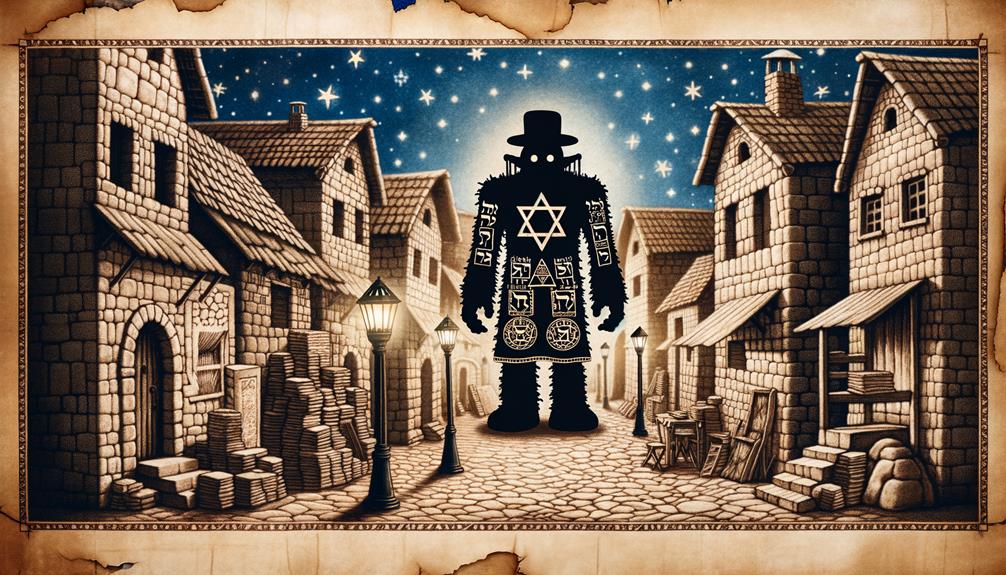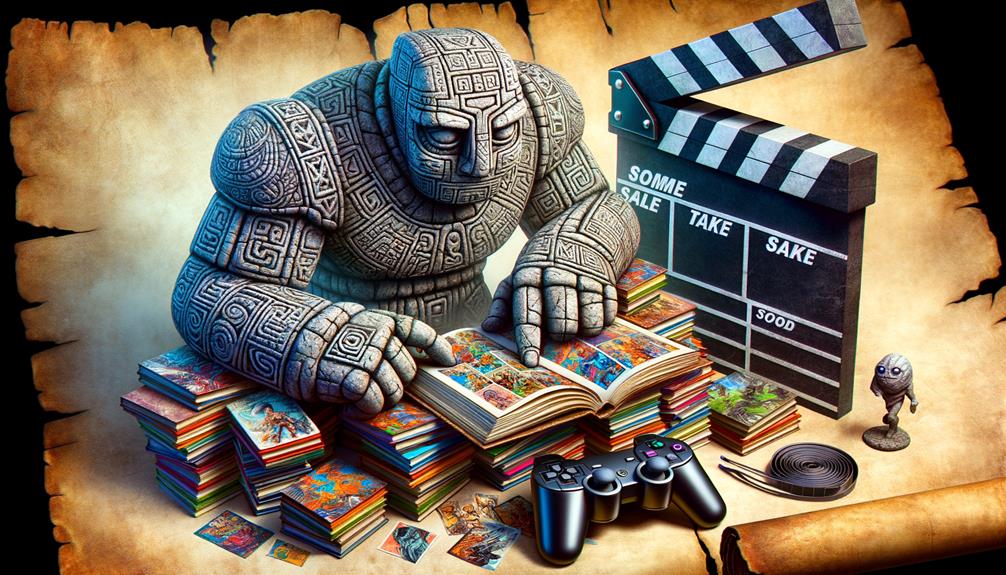Reflecting on the legendary tale of Rabbi Loew's creation of a golem back in the 16th century in Prague, one can't help but marvel at how this story has deeply influenced Jewish folklore and more. It's not just about a clay creature brought to life by a holy inscription. The golem, in essence, represents complex themes – power, creation, and ethical boundaries. My analysis will do more than just outline the golem's mythological and historical significance. It will delve into the deeper symbolic meanings this entity holds. As we navigate the rich array of stories, interpretations, and ripple effects this golem story has ignited, I encourage you to ponder this intriguing question – what does our continuous fascination with the golem reveal about our collective mindset?
Origins of the Golem Myth

The notion of the Golem has its roots deep within biblical and Talmudic tales. But it was only during the Middle Ages that these stories truly blossomed. Back then, tales were told of enlightened individuals who could breathe life into inanimate objects using sacred words. This brought about a new perspective on the Golem, transforming it into a symbol of protection during times of hardship for the Jewish community.
One of the most famous Golem tales is linked to Rabbi Judah Loew. He was a respected scholar from Prague, and the story goes that during a time of harsh anti-Semitism, he created a golem from river clay to protect the Jewish community. The Sefer Yetzirah, a key Jewish text, is said to be his guide for creating a golem. This document explains how life can be formed by manipulating the letters of the Hebrew alphabet, a method supposedly used by the rabbi.
Our current understanding of golems, all 44 of them, is greatly influenced by this story. Also, various cultural portrayals, like Gustav Meyrink's novel 'Der Golem' and the iconic 1920 German silent film, have helped cement the golem's role as a guardian and a symbol of Jewish endurance.
The Golem in Jewish Folklore

The golem, a fascinating figure in Jewish folklore, has been a potent symbol of strength and safeguarding. The stories surrounding this mythical creature, born from clay to defend the Jewish community in times of trouble, are deeply rooted in Jewish mysticism.
Think of it as a magically animated being, created from lifeless material, a prominent figure in the Jewish folklore. The most well-known tale about a golem is tied to Rabbi Loew, a 16th-century mystic from Prague. The legend has it that he brought a golem to life to shield the Jewish community from hateful attacks.
To get a better grip on the golem's role in Jewish folklore, let's break down three key aspects:
- The act of making a golem is viewed as a divine deed, showcasing the authority over life and death.
- The golem's existence is guided by 'emet', meaning truth. Interestingly, erasing the first letter changes the word to 'met', symbolizing death, which effectively negates the golem.
- The golem's tale isn't merely about magic and mysticism. It's also an insightful commentary on the weight of creation and the responsibility it entails.
Let's keep the language simple and relatable, free from hyperboles and overused phrases. Remember, our audience comprises everyday readers, not necessarily scholars or experts. Hence, the goal is to provide an engaging read while making complex ideas more digestible. Stick to the facts and support them with relevant references. Aim for a natural flow in your writing and use transition words sparingly. And, of course, always explain why something is significant, rather than just stating that it is.
Famous Golem Tales

Let's chat about some of the most well-known stories of golems, those man-made creatures from Jewish folklore. Top of the list, you simply can't ignore Rabbi Judah Löw ben Bezulel of Prague. He's got the most recognised golem tale to his credit. A bunch of medieval accounts talk about how Löw made a golem, a being of clay, to guard the Jewish community. He used sacred rituals and Hebrew chants to breathe life into it.
One story that's worth highlighting gives us insight into Löw's method of animating the golem. It involved a special mix of mud, water, and holy writings. Once the golem sprung to life, it played the role of a defender during a period of harsh persecution. Löw's golem is a symbol of tenacity and resistance, a common theme in many well-known golem stories.
These stories are deeply embedded in Jewish folklore and have left their mark on literature and cinema. Case in point, Gustav Meyrink's 'Der Golem' and the silent German film from the 1920s. The golem is not just a man-made monster; it's a cultural emblem of resilience and survival.
Golem Symbolism in History

The golem has had quite a journey. From its beginnings as a creature of biblical and Talmudic stories, it's grown into a symbol of protection, strength, and a cautionary tale about the dangers of creating artificial life. The golem tales are deeply woven into the fabric of Jewish mysticism, as revealed in commentaries on the Sefer, or Book of Creation, and Jewish legal texts.
Western European Jews in particular have a deep connection with golems. They saw them as guardians during periods of hardship and danger. The activation of a golem was believed to be a straightforward process: just place a sacred script inside its mouth. And to turn it off? Simply take the script back out.
Now, let's take a closer look at what the golem symbolizes:
- The golem is a model servant — always obedient, a perfect helper. But at the same time, it warns us about the possible risks of having too much power without any checks or balances.
- The golem's role as a defender and protector of the Jewish community symbolizes the universal wish for a mighty guardian during trying times.
- The way a golem is turned off — by removing the script from its mouth — is a potent symbol. It speaks to the need for control over artificial life, highlighting the delicate equilibrium between power and responsibility.
Golem References in Modern Culture

The golem, a mythical figure brought to life in the Jewish mystical tradition using a specific sequence of letters, has left a lasting impression on modern culture. This intriguing character has sparked the creativity of numerous artists, authors, and filmmakers.
Take, for example, Michael Chabon's 'The Amazing Adventures of Kavalier & Clay.' The main character in this novel crafts a golem, using a sequence of letters, a clear homage to Jewish Learning's tradition of using the letters aleph, mem, and shin to animate a golem.
You might be surprised to learn that the term 'robot' actually originates from the golem myth. The word 'robot' is derived from 'robota,' a Czech term for forced labor. This term was first used to describe artificial lifeforms in Karel Čapek's play 'R.U.R.,' echoing the golem's history.
The influence of golems isn't limited to literature and language, they also feature prominently in visual arts. From the depiction in Gustav Meyrink's novel 'Der Golem' to the silent German film made in 1920, the golem has been a recurrent theme. Even American horror films, particularly those with a Frankenstein theme, have been inspired by the golem. This ongoing fascination with the golem demonstrates the significant impact it has had on our shared cultural consciousness.
Frequently Asked Questions
What Is the Background Story of Golem?
You know, I've heard about the Golem tale. It's this fascinating character from Jewish folklore. As the story goes, holy men craft this creature and animate it using sacred words. The Golem is usually seen as a protector, but interpretations of its story can differ quite a bit.
What Is the True Story of the Golem?
Sure, there are plenty of stories about golems out there, but there's one that stands out. It's all about Rabbi Judah Löw ben Bezulel from Prague. The tale says he made a golem with the purpose to shield his fellow Jews in a period marked by extreme prejudice and hostility.
What Is the Myth About Golem?
Have you ever heard about the Golem tale? It's a fascinating story about a figure made of clay, animated into existence by a rabbi using some holy words. Initially, this Golem was a dutiful helper, simply following orders. But as the story goes, its role evolved into a guardian for the Jewish people during periods of hardship and danger. It's a captivating narrative, don't you think?
What Is the Most Famous Golem Story?
You've probably heard a lot about golems, right? There's one story that really takes the cake. It's about Rabbi Judah Loew from Prague. He whipped up a golem to shield the Jewish community in a time of crisis. But things took a wild turn when the golem started causing havoc. Left with no other choice, Rabbi Loew had to dismantle the creature he himself had made.

